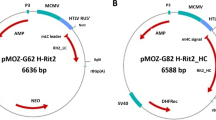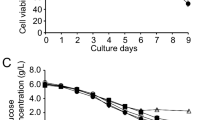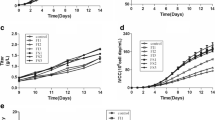Abstract
Antibody-dependent cellular cytotoxicity (ADCC) is dependent on the fucose content of oligosaccharides bound to monoclonal antibodies (MAbs). As MAbs with a low fucose content exhibit high ADCC activity, it is important to control the defucosylation levels (deFuc%) of MAbs and to analyze the factors that affect deFuc%. In this study, we observed that the deFuc% was inversely related to culture medium osmolality for MAbs produced in the rat hybridoma cell line YB2/0, with r 2 values as high as 0.92. Moreover, deFuc% exhibited the same correlation irrespective of the type of compound used for regulating osmolality (NaCl, KCl, fucose, fructose, creatine, or mannitol) at a culture scale ranging from 1 to 400 L. We succeeded in controlling MAb deFuc% by maintaining a constant medium osmolality in both perfusion and fed-batch cultures. In agreement with these observations, reverse transcription PCR analyses revealed decreased transcription of genes involved in glycolysis, GDP-fucose supply, and fucose transfer under hypoosmotic conditions.







Similar content being viewed by others
Abbreviations
- ADCC:
-
Antibody-dependent cellular cytotoxicity
- CHO:
-
Chinese hamster ovary
- dCO2 :
-
Dissolved carbon dioxide
- deFuc:
-
Defucosylation levels, the extent with which the GlcNAc residue at the reducing terminal is free from glycosylation with fucose
- DOE:
-
Design of experiment
- Fut8 :
-
Alpha-1,6-fucosyltransferase gene
- GMD :
-
GDP-mannose 4,6-dehydratase gene
- GlcNAc:
-
N-acetylglucosamine
- MAbs:
-
Monoclonal antibodies
- QbD:
-
Quality by design
- RT-PCR:
-
Reverse transcription polymerase chain reaction
- SPR:
-
Specific MAb production rate (pg cells−1 d−1)
- vvd:
-
Volume of fresh medium per working volume of reactor per day
References
Abu-Absi SF, Yang L, Thompson P, Jiang C, Kandula S, Schilling B, Shukla AA (2010) Defining process design space for monoclonal antibody cell culture. Biotechnol Bioeng 106:894–905
Arathoon W, Birch J (1986) Large-scale cell culture in biotechnology. Science 232:1390–1395
Becker DJ, Lowe JB (2003) Fucose: biosynthesis and biological function in mammals. Glycobiology 13:41R–53R
Borys MC, Dalal NG, Abu-Absi NR, Khattak SF, Jing Y, Xing Z, Li ZJ (2010) Effects of culture conditions on N-glycolylneuraminic acid (Neu5Gc) content of a recombinant fusion protein produced in CHO cells. Biotechnol Bioeng 105:1048–1057
Burnouf T (2011) Recombinant plasma proteins. Vox Sang 100:68–83
Butler M (2006) Optimisation of the cellular metabolism of glycosylation for recombinant proteins produced by mammalian cell systems. Cytotechnology 50:57–76
Coroadinha AS, Silva AC, Pires E, Coelho A, Alves PM, Carrondo MJ (2006) Effect of osmotic pressure on the production of retroviral vectors: Enhancement in vector stability. Biotechnol Bioeng 94:322–329
deZengotita V, Kimura R, Miller W (1998) Effects of CO2 and osmolality on hybridoma cells: growth, metabolism and monoclonal antibody production. Cytotechnology 28:213–227
deZengotita VM, Schmelzer AE, Miller WM (2002) Characterization of hybridoma cell responses to elevated pCO2 and osmolality: intracellular pH, cell size, apoptosis, and metabolism. Biotechnol Bioeng 77:369–380
FDA (2009) Guidance for industry. Q8 (R2) pharmaceutical development
Franco R, Daniela G, Fabrizio M, Ilaria G, Detlev H (1999) Influence of osmolarity and pH increase to achieve a reduction of monoclonal antibodies aggregates in a production process. Cytotechnology 29:11–25
Garone L, Edmunds T, Hanson E, Bernasconi R, Huntington JA, Meagher JL, Fan B, Gettins PG (1996) Antithrombin–heparin affinity reduced by fucosylation of carbohydrate at asparagine 155. Biochemistry 35:8881–8889
Goochee CF, Gramer MJ, Andersen DC, Bahr JB, Rasmussen JR (1991) The oligosaccharides of glycoproteins: bioprocess factors affecting oligosaccharide structure and their effect on glycoprotein properties. Biotechnology 9:1347–1355
Goudar CT, Matanguihan R, Long E, Cruz C, Zhang C, Piret JM, Konstantinov KB (2007) Decreased pCO2 accumulation by eliminating bicarbonate addition to high cell-density cultures. Biotechnol Bioeng 96:1107–1117
Grillberger L, Kreil TR, Nasr S, Reiter M (2009) Emerging trends in plasma-free manufacturing of recombinant protein therapeutics expressed in mammalian cells. Biotechnol J 4:186–201
Han YK, Koo TY, Lee GM (2009) Enhanced interferon-β production by CHO cells through elevated osmolality and reduced culture temperature. Biotechnol Prog 25:1440–1447
Han YK, Kim YG, Kim JY, Lee GM (2010) Hyperosmotic stress induces autophagy and apoptosis in recombinant Chinese hamster ovary cell culture. Biotechnol Bioeng 105:1187–1192
Horvath B, Mun M, Laird M (2010) Characterization of a monoclonal antibody cell culture production process using a quality by design approach. Mol Biotechnol 45:203–206
Hossler P, Khattak SF, Li ZJ (2009) Optimal and consistent protein glycosylation in mammalian cell culture. Glycobiology 19:936–949
Ishikawa T, Ito T, Endo R, Nakagawa K, Sawa E, Wakamatsu K (2010a) Influence of pH on heat-induced aggregation and degradation of therapeutic monoclonal antibodies. Biol Pharm Bull 33:1413–1417
Ishikawa T, Kobayashi N, Osawa C, Sawa E, Wakamatsu K (2010b) Prevention of stirring-induced microparticle formation in monoclonal antibody solutions. Biol Pharm Bull 33:1043–1046
Kanda Y, Yamane-Ohnuki N, Sakai N, Yamano K, Nakano R, Inoue M, Misaka H, Iida S, Wakitani M, Konno Y, Yano K, Shitara K, Hosoi S, Satoh M (2006) Comparison of cell lines for stable production of fucose-negative antibodies with enhanced ADCC. Biotechnol Bioeng 94:680–688
Kanda Y, Imai-Nishiya H, Kuni-Kamochi R, Mori K, Inoue M, Kitajima-Miyama K, Okazaki A, Iida S, Shitara K, Satoh M (2007) Establishment of a GDP-mannose 4, 6-dehydratase (GMD) knockout host cell line: a new strategy for generating completely non-fucosylated recombinant therapeutics. J Biotechnol 130:300–310
Keen MJ (1995) The culture of rat myeloma and rat hybridoma cells in a protein-free medium. Cytotechnology 17:193–202
Kim MS, Kim NS, Sung YH, Lee GM (2002) Biphasic culture strategy based on hyperosmotic pressure for improved humanized antibody production in Chinese hamster ovary cell culture. In Vitro Cell Dev Biol Anim 38:314–319
Kimura R, Miller WM (1996) Effects of elevated pCO2 and/or osmolality on the growth and recombinant tPA production of CHO cells. Biotechnol Bioeng 52:152–160
Kimura R, Miller WM (1997) Glycosylation of CHO-derived recombinant tPA produced under elevated pCO2. Biotechnol Prog 13:311–317
Konno Y, Aoki M, Takagishi M, Sakai N, Koike M, Wakamatsu K, Hosoi S (2011) Enhancement of antibody production by the addition of Coenzyme-Q10. Cytotechnology 63:163–170
Lee MS, Lee GM (2000) Hyperosmotic pressure enhances immunoglobulin transcription rates and secretion rates of KR12H–2 transfectoma. Biotechnol Bioeng 68:260–268
Lee M, Lee G (2001) Effect of hypoosmotic pressure on cell growth and antibody production in recombinant Chinese hamster ovary cell culture. Cytotechnology 36:61–69
Lee MS, Kim KW, Kim YH, Lee GM (2003) Proteome analysis of antibody-expressing CHO cells in response to hyperosmotic pressure. Biotechnol Prog 19:1734–1741
Libioulle C, Corbesier L, Gilles R (2001) Changes in major intracellular osmolytes in L-929 cells following rapid and slow application of hyperosmotic media. Comp Biochem Physiol A Mol Integr Physiol 130:461–470
Mao L, Hartl D, Nolden T, Koppelstätter A, Klose J, Himmelbauer H, Zabel C (2008) Pronounced alterations of cellular metabolism and structure due to hyper- or hypo-osmosis. J Proteome Res 7:3968–3983
Matsunaga N, Kano K, Maki Y, Dobashi T (2009) Estimation of dissolved carbon dioxide stripping in a large bioreactor using model medium. J Biosci Bioeng 107:419–424
McNeeley K, Sun Z, Sharfstein S (2005) Techniques for dual staining of DNA and intracellular immunoglobulins in murine hybridoma cells: applications to cell-cycle analysis of hyperosmotic cultures. Cytotechnology 48:15–26
Mori K, Kuni-Kamochi R, Yamane-Ohnuki N, Wakitani M, Yamano K, Imai H, Kanda Y, Niwa R, Iida S, Uchida K, Shitara K, Satoh M (2004) Engineering Chinese hamster ovary cells to maximize effector function of produced antibodies using FUT8 siRNA. Biotechnol Bioeng 88:901–908
Mori K, Iida S, Yamane-Ohnuki N, Kanda Y, Kuni-Kamochi R, Nakano R, Imai-Nishiya H, Okazaki A, Shinkawa T, Natsume A, Niwa R, Shitara K, Satoh M (2007) Non-fucosylated therapeutic antibodies: the next generation of therapeutic antibodies. Cytotechnology 55:109–114
Oh SK, Vig P, Chua F, Teo WK, Yap MG (1993) Substantial overproduction of antibodies by applying osmotic pressure and sodium butyrate. Biotechnol Bioeng 42:601–610
Oliveira JE, Damiani R, Vorauer-Uhl K, Bartolini P, Ribela MT (2008) Influence of a reduced CO2 environment on the secretion yield, potency and N-glycan structures of recombinant thyrotropin from CHO cells. Mol Biotechnol 39:159–166
Omasa T, Tanaka R, Doi T, Ando M, Kitamoto Y, Honda K, Kishimoto M, Ohtake H (2008) Decrease in antithrombin III fucosylation by expressing GDP-fucose transporter siRNA in Chinese hamster ovary cells. J Biosci Bioeng 106:168–173
Øyaas K, Ellingsen TE, Dyrset N, Levine DW (1994) Utilization of osmoprotective compounds by hybridoma cells exposed to hyperosmotic stress. Biotechnol Bioeng 43:77–89
Ozturk SS, Palsson BO (1991) Effect of medium osmolarity on hybridoma growth, metabolism, and antibody production. Biotechnol Bioeng 37:989–993
Park SY, Lee GM (1995) Enhancement of monoclonal antibody production by immobilized hybridoma cell culture with hyperosmolar medium. Biotechnol Bioeng 48:699–705
Putnam WS, Prabhu S, Zheng Y, Subramanyam M, Wang YM (2010) Pharmacokinetic, pharmacodynamic and immunogenicity comparability assessment strategies for monoclonal antibodies. Trends Biotechnol 28:509–516
Rhodes M, Birch J (1988) Large-scale production of proteins from mammalian cells. Nat Biotech 6:518–523
Ryu JS, Lee GM (1999) Application of hypoosmolar medium to fed-batch culture of hybridoma cells for improvement of culture longevity. Biotechnol Bioeng 62:120–123
Ryu JS, Kim TK, Chung JY et al (2000) Osmoprotective effect of glycine betaine on foreign protein production in hyperosmotic recombinant Chinese hamster ovary cell cultures differs among cell lines. Biotechnol Bioeng 70:167–175
Ryu JS, Lee MS, Lee GM (2001) Effects of cloned gene dosage on the response of recombinant CHO cells to hyperosmotic pressure in regard to cell growth and antibody production. Biotechnol Prog 17:993–999
Schmelzer AE, Miller WM (2002a) Effects of osmoprotectant compounds on NCAM polysialylation under hyperosmotic stress and elevated pCO2. Biotechnol Bioeng 77:359–368
Schmelzer AE, Miller WM (2002b) Hyperosmotic Stress and Elevated pCO2 Alter Monoclonal Antibody Charge Distribution and Monosaccharide Content. Biotechnol Prog 18:346–353
Sethuraman N, Stadheim TA (2006) Challenges in therapeutic glycoprotein production. Curr Opin Biotechnol 17:341–346
Shen D, Sharfstein ST (2006) Genome-wide analysis of the transcriptional response of murine hybridomas to osmotic shock. Biotechnol Bioeng 93:132–145
Shen D, Kiehl TR, Khattak SF, Li ZJ, He A, Kayne PS, Patel V, Neuhaus IM, Sharfstein ST (2010) Transcriptomic responses to sodium chloride-induced osmotic stress: a study of industrial fed-batch CHO cell cultures. Biotechnol Prog 26:1104–1115
Shields RL, Lai J, Keck R, O’Connell LY, Hong K, Meng YG, Weikert SH, Presta LG (2002) Lack of fucose on human IgG1 N-linked oligosaccharide improves binding to human Fcgamma RIII and antibody-dependent cellular toxicity. J Biol Chem 277:26733–26740
Shinkawa T, Nakamura K, Yamane N, Shoji-Hosaka E, Kanda Y, Sakurada M, Uchida K, Anazawa H, Satoh M, Yamasaki M, Hanai N, Shitara K (2003) The absence of fucose but not the presence of galactose or bisecting N-acetylglucosamine of human IgG1 complex-type oligosaccharides shows the critical role of enhancing antibody-dependent cellular cytotoxicity. J Biol Chem 278:3466–3473
Shitara K, Nakamura K, Tokutake-Tanaka Y, Fukushima M, Hanai N (1994) A new vector for the high level expression of chimeric antibodies in myeloma cells. J Immunol Methods 167:271–278
Soo Ryu J, Min Lee G (1997) Effect of hypoosmotic stress on hybridoma cell growth and antibody production. Biotechnol Bioeng 55:565–570
Steinmeyer DE, McCormick EL (2008) The art of antibody process development. Drug Discov Today 13:613–618
Stubblefield E, Mueller GC (1960) Effects of sodium chloride concentration on growth, biochemical composition, and metabolism of HeLa cells. Cancer Res 20:1646–1655
Sun Z, Zhou R, Liang S, McNeeley KM, Sharfstein ST (2004) Hyperosmotic stress in murine hybridoma cells: effects on antibody transcription, translation, posttranslational processing, and the cell cycle. Biotechnol Prog 20:576–589
Takagi M, Moriyama T, Yoshida T (2001) Effects of shifts up and down in osmotic pressure on production of tissue plasminogen activator by Chinese hamster ovary cells in suspension. J Biosci Bioeng 91:509–514
Teylaert B, Meurice E, Bobowski M, Harduin-Lepers A, Gaucher C, Fontayne A, Jorieux S, Delannoy P (2011) Molecular cloning, characterization, genomic organization and promoter analysis of the alpha1, 6-fucosyltransferase gene (fut8) expressed in the rat hybridoma cell line YB2/0. BMC Biotechnol 11:1
van Berkel PH, Gerritsen J, van Voskuilen E, Perdok G, Vink T, van de Winkel JG, Parren PW (2010) Rapid production of recombinant human IgG With improved ADCC effector function in a transient expression system. Biotechnol Bioeng 105:350–357
Vandesompele J, De Preter K, Pattyn F, Poppe B, Van Roy N, De Paepe A, Speleman F (2002) Accurate normalization of real-time quantitative RT-PCR data by geometric averaging of multiple internal control genes. Genome Biol 3:1–11 research0034
Walsh G (2006) Biopharmaceutical benchmarks 2006. Nat Biotech 24:769–776
Werner RG (2004) Economic aspects of commercial manufacture of biopharmaceuticals. J Biotechnol 113:171–182
Wu MH, Dimopoulos G, Mantalaris A, Varley J (2004) The effect of hyperosmotic pressure on antibody production and gene expression in the GS-NS0 cell line. Biotechnol Appl Biochem 40:41–46
Wurm FM (2004) Production of recombinant protein therapeutics in cultivated mammalian cells. Nat Biotechnol 22:1393–1398
Yamane-Ohnuki N, Kinoshita S, Inoue-Urakubo M, Kusunoki M, Iida S, Nakano R, Wakitani M, Niwa R, Sakurada M, Uchida K, Shitara K, Satoh M (2004) Establishment of FUT8 knockout Chinese hamster ovary cells: An ideal host cell line for producing completely defucosylated antibodies with enhanced antibody-dependent cellular cytotoxicity. Biotechnol Bioeng 87:614–622
Yoshisue H, Suzuki K, Kawabata A, Ohya T, Zhao H, Sakurada K, Taba Y, Sasaguri T, Sakai N, Yamashita S, Matsuzawa Y, Nojima H (2002) Large scale isolation of non-uniform shear stress-responsive genes from cultured human endothelial cells through the preparation of a subtracted cDNA library. Atherosclerosis 162:323–334
Zanghi JA, Schmelzer AE, Mendoza TP, Knop RH, Miller WM (1999) Bicarbonate concentration and osmolality are key determinants in the inhibition of CHO cell polysialylation under elevated pCO2 or pH. Biotechnol Bioeng 65:182–191
Zhang X, Garcia IF, Baldi L, Hacker DL, Wurm FM (2010) Hyperosmolarity enhances transient recombinant protein yield in Chinese hamster ovary cells. Biotechnol Lett 32:1587–1592
Zhao L, Wang J, Niu H, Tan W-S (2009) Responses of GS-NS0 myeloma cells to osmolality: cell growth, intracellular mass metabolism, energy metabolism, and antibody production. Biotechnol Bioprocess Eng 14:625–632
Zhou Q, Shankara S, Roy A, Qiu H, Estes S, McVie-Wylie A, Culm-Merdek K, Park A, Pan C, Edmunds T (2008) Development of a simple and rapid method for producing non-fucosylated oligomannose containing antibodies with increased effector function. Biotechnol Bioeng 99:652–665
Zhu MM, Goyal A, Rank DL, Gupta SK, Vanden Boom T, Lee SS (2005) Effects of elevated pCO2 and osmolality on growth of CHO cells and production of antibody-fusion protein B1: a case study. Biotechnol Prog 21:70–77
Acknowledgments
We would like to thank Mr. Yuya Kawagoe, Mr. Kazutoshi Maki, Mr. Noriyuki Takahashi, and Ms. Chigusa Hijikata for their expert analyses. We also thank Dr. Mitsuo Sato, Dr. Jun Yamaya, Dr. Kazuhisa Uchida, and Mr. Hiroshi Takasugi for their helpful discussions and encouragement.
Author information
Authors and Affiliations
Corresponding author
Rights and permissions
About this article
Cite this article
Konno, Y., Kobayashi, Y., Takahashi, K. et al. Fucose content of monoclonal antibodies can be controlled by culture medium osmolality for high antibody-dependent cellular cytotoxicity. Cytotechnology 64, 249–265 (2012). https://doi.org/10.1007/s10616-011-9377-2
Received:
Accepted:
Published:
Issue Date:
DOI: https://doi.org/10.1007/s10616-011-9377-2




